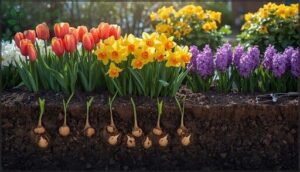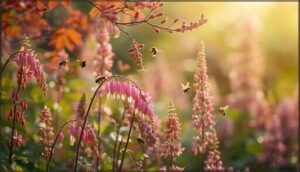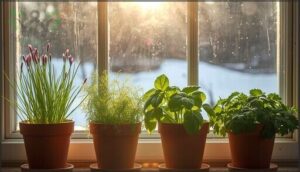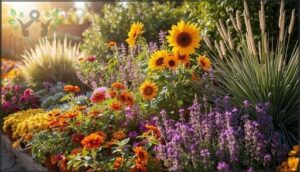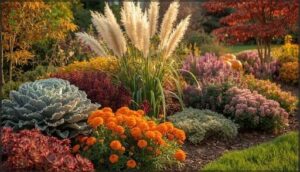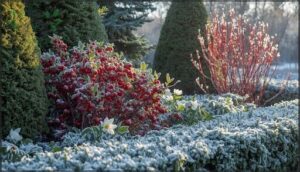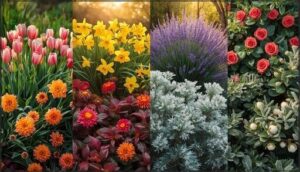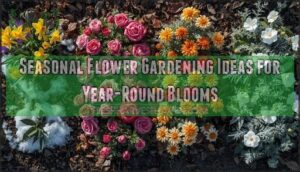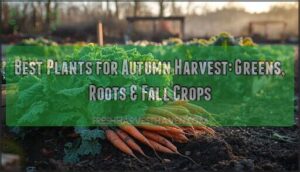This site is supported by our readers. We may earn a commission, at no cost to you, if you purchase through links.

Your garden doesn’t have to choose between a stunning spring show and barren winter beds. The secret to a landscape that turns heads year-round lies in understanding which plants hit their stride in each season—and strategically placing them so one performer exits as another takes the stage.
While most gardeners plant impulsively in spring and watch their gardens fade by August, savvy planters work backward from their climate zone, selecting the best plants for each season before they ever break ground. This approach transforms your outdoor space from a three-month wonder into a vibrant display that shifts with the weather.
From frost-defying hellebores that bloom through snow to heat-loving zinnias that laugh at summer droughts, you’ll discover which species thrive when others struggle—and how to orchestrate them into a garden that never goes dark.
Table Of Contents
Key Takeaways
- Strategic year-round garden planning starts by working backward from your climate zone and selecting plants that peak in different seasons, creating continuous visual interest rather than a single spring burst followed by barren beds.
- Native spring perennials attract 37% more pollinators than cultivated varieties, while succession planting vegetables every 7-14 days delivers continuous harvests instead of overwhelming single yields.
- Drought-resistant plants like sedum, native prairie grasses, and lavender can reduce summer irrigation needs by 60% compared to traditional landscapes while maintaining vibrant blooms through heat stress.
- Winter-blooming plants like hellebores and witch hazel provide essential nectar for pollinators during scarce months, while winterberry holly sustains 48 bird species with berry clusters that persist from September through January.
Best Spring Plants for Vibrant Gardens
Spring is the season when your garden comes alive after winter’s rest, and choosing the right plants sets the tone for the entire growing year. You’ll want a mix that delivers early color, provides fresh food for your table, and nourishes the pollinators that make everything else possible.
Here’s what to plant now for a spring garden that truly performs.
Top Spring-Flowering Bulbs (Tulips, Daffodils, Hyacinths)
Spring gardening starts with tulips, daffodils, and hyacinths—the triumphant trio that turns your beds into living color. These bulbs demand well-drained soil and careful planting depth: 6–8 inches for larger bulb varieties works best.
For success in seasonal gardening and stunning flower arrangements:
- Plant from late September through November before ground freeze
- Chill tulips 45–60 days in warmer regions for proper bloom
- Space bulbs strategically in garden designs for maximum visual impact
Understanding the proper bulb planting depths is essential for a vibrant display.
Spring Vegetables for Early Harvest (Lettuce, Spinach, Peas)
Beyond ornamental blooms, your spring garden’s liberation starts with fast-yielding vegetables. Lettuce, spinach, and peas rule the early harvest game. These crops align perfectly with soil preparation and seed-starting timelines, moving from transplant to table in 40–60 days. This gives you total control over your growing season. Understanding cool weather crops is essential for a successful early spring garden.
| Crop | Days to Harvest | Ideal Temperature | Nutrients Per Serving | Garden Planning Tip |
|---|---|---|---|---|
| Lettuce | 52 days (sowing to transplant) | Spring cool conditions | 50% daily Vitamin K | Transplant intervals: 9 days early spring |
| Spinach | 4–6 weeks | 57°F–68°F daytime | 160% Vitamin A, 510% Vitamin K | Best for crop rotation in cool zones |
| Peas | ~60 days | Cool spring weather | 8g protein, 7g fiber per cup | Plant early April for June harvest timing |
| Asian Greens | 15–21 days | Cool to moderate | Varies by variety | Quick succession for continuous yield |
| Cress | 15–21 days | Cool spring temps | High in antioxidants | Excellent for rapid spring gardening cycles |
Master harvest timing through staggered vegetable gardening. Space sowings 5–9 days apart for continuous seasonal planting success throughout spring.
Native Spring Perennials for Pollinators
Your vegetable plot’s hard work isn’t complete without native plant selection that fuels pollinator conservation. Red maple (Acer rubrum) and showy milkweed (Asclepias speciosa) bring spring bloom timing and biodiversity support to your pollinator-friendly gardens.
Over 80 North American perennials deliver nectar when bees emerge—wild bleeding heart blooms April through November. Spring gardening with natives attracts 37% more pollinators than cultivated varieties, transforming plant selection into ecosystem command.
Early-Season Herbs to Plant in Spring
Chives, parsley, dill, and basil deliver your spring herb garden’s culinary punch when you start them indoors 6-8 weeks before the last frost.
You’ll achieve 90-95% survival rates after proper hardening off—7 to 10 days acclimating seedlings outdoors.
Indoor sowing at 16°C soil temperatures ensures herb seed viability stays strong, while early planting boosts yields by 34% through seasonal gardening synchronization.
Summer Standouts: Plants That Thrive in Heat
When summer heat arrives, your garden doesn’t have to wilt—it can flourish. The key is choosing plants that actually love the warmth and won’t demand constant babysitting through those scorching months.
Here’s your lineup of summer champions that’ll keep your garden thriving from June through August.
Sun-Loving Summer Flowers (Sunflowers, Zinnias, Marigolds)
When the summer sun blazes overhead, sunflowers, zinnias, and marigolds take center stage in your flower gardening efforts. These summer blooms thrive in full sun exposure (sunflowers need 68–77°F for ideal growth), delivering continuous summer bloom times from early summer through frost.
Their heat tolerance makes them perfect for garden layouts focused on pollinator support, attracting bees and butterflies while providing stunning material for flower arrangements throughout your summer gardening season.
Heat-Tolerant Summer Vegetables (Tomatoes, Peppers, Eggplants)
When heatwaves threaten your summer harvest, tomatoes, peppers, and eggplants prove their worth as resilient summer vegetables in your gardening guide. These crops demand soil temperature above 70°F and nighttime lows consistently above 60°F for healthy fruit set.
Heat stress diminishes when you maintain garden irrigation at soil level and apply mulch to regulate temperature. Selecting heat-tolerant varieties bred through sophisticated vegetable breeding ensures productive summer gardening even when daytime highs push past 90°F.
Drought-Resistant Plant Choices for Summer
When scorching temperatures and water restrictions threaten your summer gardening plans, drought-resistant plants offer liberation through xeric landscaping principles. These champions of water conservation thrive in desert gardens while maintaining vibrant summer blooms:
- Sedum species survive extended droughts with 90%+ success rates
- Native prairie grasses like Little Bluestem retain 85% green biomass during dry spells
- Echinacea and Rudbeckia flower for 12 weeks with minimal rainfall
- Russian Sage blooms 10+ weeks with only monthly watering
- Lavender cultivars demand just deep monthly irrigation
Sustainable gardening techniques using drought-resistant plants reduce summer irrigation by 60% compared to traditional landscapes.
Summer Herbs and Their Care
Basil, rosemary, mint, oregano, and thyme dominate herb gardening during summer, thriving when you master their specific care requirements. Focus on herb watering schedules—basil needs 1.5 inches weekly, while Mediterranean herbs prefer drier soil between irrigation.
Apply balanced herb fertilization sparingly to preserve flavor oils, and implement pest control through routine inspections for aphids. Summer pruning encourages bushier growth, and maintaining excellent soil quality through proper drainage ensures your herbs flourish despite heat.
Fall Favorites: Plants for Autumn Interest
Fall doesn’t mean your garden has to fade into the background. You can keep your landscape looking vibrant with plants that truly come alive as temperatures cool and daylight shifts.
Let’s look at the best autumn performers that’ll give you color, texture, and even food through the season.
Autumn-Blooming Flowers (Chrysanthemums, Asters)
When other blooms fade, chrysanthemums and asters steal the show in your fall garden design. These autumn gardening champions transform landscapes with vibrant fall colors—chrysanthemums offering over 20,000 cultivated varieties in bronze, plum, and fiery reds, while aster varieties bloom from August through October. Here’s why they’re essential for seasonal gardening:
- Seasonal pollinators rely on these late-blooming flowers as essential nectar sources
- Chrysanthemum care is straightforward: space plants 18-24 inches apart in full sun
- Autumn flower arrangements stay vibrant for four to six weeks, maximizing your gardening guide results
Cool-Season Vegetables for Fall Harvest
You can reclaim control of your food supply through fall gardening tips that deliver fresh harvests when summer crops fade. Cool season crops like kale, carrots, and broccoli thrive in autumn gardening conditions, offering excellent seasonal nutrition with vitamin-rich leafy greens.
These vegetables demonstrate impressive winter hardiness—radishes mature in just 20–40 days, while your garden planning strategies for vegetable harvesting extend productivity well into cooler months. This seasonal gardening approach transforms your gardening guide into a year-round resource.
Ornamental Grasses and Foliage for Fall Color
Beyond food crops, you’ll find liberation in ornamental grasses that deliver breathtaking fall color dynamics with minimal garden maintenance. Species like Miscanthus sinensis ‘Dronning Ingrid’ showcase coppery-red foliage texture while Panicum virgatum ‘Shenandooh’ blazes burgundy through autumn gardening season. These grass species offer ecological benefits, supporting up to 40% more pollinators and birds. Best of all? They thrive with little seasonal maintenance once established.
- Miscanthus sinensis displays persistent winter seed plumes
- Panicum virgatum peaks in late October brilliance
- Muhlenbergia capillaris produces vivid pink autumn inflorescences
- Helictotrichon sempervirens contrasts with steel-blue year-round foliage
Fall-Planted Bulbs for Spring Blooms
While grasses paint fall’s finale, you’re simultaneously planting spring’s opening act. Fall bulb planting transforms your seasonal gardening strategy—tulips, daffodils, and hyacinths need 12–16 weeks of cold hardiness below 10°C.
Your bulb selection matters: plant large varieties 20 cm deep when soil temperature drops below 13°C, usually mid-September through early November. Proper planting depth ensures 80% survival rates and stunning bloom periods spanning March through May.
Winter Wonders: Plants for Cold Seasons
Winter doesn’t have to mean a lifeless garden. You can fill those cold months with unexpected blooms, striking evergreens, and vibrant berries that actually thrive when temperatures drop.
Here’s what you need to know about plants that bring life to your winter landscape.
Winter-Flowering Plants (Hellebores, Witch Hazel)
When most plants surrender to winter’s grip, hellebores and witch hazel stage their quiet rebellion. These cold-hardy plants deliver winter blooms that defy frost protection norms—hellebores unfurling cup-shaped flowers in late winter, witch hazel’s ribbon-like petals surviving freeze-thaw cycles for eight weeks.
Both offer pollinator support when nectar’s scarce, plus deer resistance that keeps your winter gardening efforts intact. They’re your garden’s insurance policy against seasonal monotony.
Evergreens and Berries for Winter Interest (Winterberry Holly)
Winterberry holly transforms cold climate landscaping with scarlet berry clusters that punch through winter’s drab palette. This deciduous evergreen loses leaves but retains berries from September through January—your wildlife support system feeding 48 bird species when food’s scarce.
Plant male and female varieties (‘Mr. Poppins’ works) within 50 feet for berry production tips that actually deliver. Zones 3-9, acidic soil, and you’ve mastered winter garden design that sustains life.
Best Indoor Plants for Winter Months
When natural light disappears and indoor air turns bone-dry, you’ll need allies that won’t surrender. ZZ plants and pothos handle low light conditions like champions, while kalanchoe delivers winter blooms without demanding attention.
Your humidity control matters more than you think—group plants together or run a humidifier to hit that 40-60% sweet spot.
Skip the air purification myths; these beauties offer psychological wins, not detoxification miracles.
Protecting Perennials and Shrubs in Winter
Once your perennials enter dormancy, apply 2-3 inches of winter mulching after the first hard freeze—this soil insulation cuts root injury by 40% and prevents heaving through freeze-thaw cycles. Deep watering before ground freeze improves winter hardiness markedly.
Wrap vulnerable shrubs in burlap for frost protection against windburn, and construct wind barriers on exposed sides.
Cold acclimation happens naturally, but you’ll boost survival rates with these targeted defenses.
Year-Round Plant Selection and Care
Creating a garden that looks its best all year takes more than just picking pretty plants—you need a strategy that keeps your beds full of life through every season. The key is choosing the right perennials, preparing your soil properly, and staying on top of seasonal tasks that keep everything thriving.
Let’s look at how you can build a garden that delivers color, texture, and interest no matter what month it’s.
Choosing Perennials for Seasonal Continuity
You can master garden planning by selecting perennials strategically for seasonal color throughout the year. Surveys show that perennials now comprise over 68% of new garden installations, thanks to their reliable year-round garden performance.
Here’s how to achieve seasonal continuity:
- Choose long-blooming varieties like ‘Walker’s Low’ Catmint (five-month bloom period)
- Match plant hardiness zones to your climate
- Prepare beds with soil enrichment using organic compost
These seasonal gardening tips guarantee consistent plant care and garden maintenance success.
Planning for Continuous Bloom Throughout The Year
You can achieve continuous garden color by mapping bloom sequences across all four seasons. Strategic garden layering—combining bulbs with perennials and shrubs—extends visible blooms up to 44 weeks in temperate climates.
Pair spring tulips with summer daylilies, then shift to fall asters for smooth seasonal shifts.
This planting seasons approach aids pollinator support while adapting to climate adaptation challenges in your year-round garden.
Soil Preparation and Seasonal Amendments
Your soil health drives every bloom, and smart seasonal amendments make that happen. Testing reveals nutrient gaps—46% of soils test below critical phosphorus thresholds—while boosting organic matter from 1% to 3% cuts erosion by up to 33%. Fertilizing strategically and managing compost throughout the year builds microbial balance that peaks in winter.
- Test soil annually to track pH shifts and nutrient depletion
- Add compost in fall when microbial biomass naturally increases
- Apply organic matter before spring planting to release nitrogen slowly
- Monitor soil moisture—it influences microbes more than temperature does
- Use composite amendments in sandy soils for 92% yield improvements
Seasonal Maintenance Tips for Healthy Plants
Think of seasonal gardening as staying one step ahead—your plants reward preparation. Pruning techniques in late winter slash disease by 32%, while mulching retains 30% more moisture for summer water conservation. Early pest management cuts infestations by 35%, and spring fertilization strategies boost growth by 20%. Deadheading through the season increases blooms by 30%.
Seasonal preparation—winter pruning, mulching, pest control, spring feeding, and deadheading—delivers disease cuts, moisture retention, and bloom increases your plants reward with vigor
Smart garden maintenance timing transforms plant care and maintenance from reactive guesswork into confident gardening tips you’ll use year-round.
Frequently Asked Questions (FAQs)
How do I start a pollinator-friendly garden?
Start your pollinator garden by selecting native plants that bloom continuously from spring through fall.
Prepare soil with compost, avoid pesticides, and position beds where they’ll receive at least eight hours of daily sunlight.
What are the best natural pest control methods?
You can deploy biological control by releasing beneficial insects like parasitic wasps and ladybugs, which reduce pest populations by over 60%.
Companion planting with herbs also repels harmful insects naturally and effectively.
When should I start seeds indoors for transplanting?
Like clockwork ticking toward spring’s arrival, your seed starting schedule hinges on frost dates and transplant timing.
Most vegetables need 6–8 weeks indoors, while flowers require 4–10 weeks before outdoor soil temperature permits safe gardening by season.
How can I conserve water in my garden?
You’ll slash water use by installing drip irrigation, applying mulch for soil moisture retention, and choosing drought-resistant plants.
Greywater systems and deep watering twice weekly boost water efficiency while supporting sustainable gardening practices and soil conservation.
What is succession planting and how does it work?
Succession planting means sowing crops at timed intervals—every 7 to 14 days—ensuring a continuous harvest instead of one overwhelming yield.
This garden planning strategy maximizes your year-round garden’s productivity while reducing waste throughout the season.
Conclusion
Don’t put all your eggs in one basket—or all your blooms in one season. Selecting the best plants for each season transforms your garden from a fleeting spectacle into a perpetual performance.
You’ve gained the framework: spring bulbs yield to summer’s heat-lovers, fall perennials bridge to winter’s evergreen stalwarts. Now execute with intention.
Map your beds by bloom time, prepare soil seasonally, and watch your landscape defy dormancy while neighbors wonder how you cracked the code.
- https://todayshomeowner.com/lawn-garden/guides/most-popular-spring-flower-by-state/
- https://www.themarthablog.com/2025/03/spring-emergence-2025.html
- https://www.greenhousemag.com/news/proven-winners-2025-perennial-survey-trends-strong-demand/
- http://www.usanpn.org/data/maps/spring
- https://www.housebeautiful.com/lifestyle/gardening/a64979842/cottage-gardens-summer-2025-trend/

